Special Hobby 1/48 Piper L-4 "Grasshopper"
The Airplane:
In 1929 engineer Clarence Gilbert Taylor created a light tourism plane which was economical to operate. The first flight of the prototype took place in September 1930 and the aircraft was baptized “Taylor E2 Cub”.
Following bankruptcy, Taylor's company was purchased in December 1930 by businessman William T. Piper, an investor in the original company, and renamed Piper Aircraft with Piper keeping founder Taylor on as president. In 1936, an E2 Cub was modified by employee Walter Jamouneau to become the J-2 while Taylor was on sick leave. When he saw the redesign, Taylor was so incensed he fired Jamouneau. However, Piper who had encouraged Jamouneau's changes, hired him back and bought out Taylor's share in the company, paying him $250 per month for three years.
Although sales were initially slow, some 1,200 J-2s had been produced when a fire in the factory, a former silk mill in Bradford, Pennsylvania, ended its production in 1938. Piper moved the company to Lock Haven, Pennsylvania, where the J-3 - which featured further changes by Jamouneau - replaced the J-2. With a unit price just over $1,000, the new design sold 700 copies in 1938.
In 1939, the Civil Aviation Administration selected the “Piper Cub” as its main training plane for the Civilian Pilot Training program established at U.S. colleges and universities. In 1940 3,016 copies were shipped from the factory; it only took twenty minutes to build a Piper J-3. First Lady Eleanor Roosevelt took a flight in a J-3 Cub, posing for a series of publicity photos to help promote the CPT.
In June 1941, the airplane was selected by the Army Air Corps for a light battlefield observation aircraft. Originally designated O-59, the plane was redesignated L-4 (“L” for liaison) in April 1942. The L-4 was mechanically identical to the civilian J-3 Cub, but was distinguishable by the use of a Plexiglas greenhouse skylight and rear windows for improved visibility. Powered by a 65 hp Continental O-170, it had a maximum speed of 85 mph and a cruising speed of 75 mph, with a range of 190 miles, with a single occupant. 5,413 L-4s were produced for U.S. forces, including 250 built for the U.S. Navy under contract as the NE-1 and NE-2.
All L-4 models, as well as similar, tandem-cockpit accommodation aircraft from Aeronca and Taylorcraft, were collectively nicknamed "Grasshoppers", though the L-4 was almost universally referred to by its civilian designation of Cub. The L-4 was engaged in all theaters of operations of the US Army during the Second World War. During the Battle of Normandy in June 1944, the L-4's slow cruising speed and low-level maneuverability made it an ideal observation platform for spotting hidden German armor waiting in ambush in the hedgerows of the bocage country south of the invasion beaches. For these operations, the pilot generally carried both an observer/radio operator and a 25-pound communications radio, a load that often exceeded the plane's specified weight capacity.
After the Allied breakout from Normandy, L-4s were sometimes equipped with improvised racks, usually in pairs or quartets, of infantry bazookas for ground attack against German armored units. The most famous of these was “Rosie the Rocketeer,” flown by Major Charles "Bazooka Charlie" Carpenter; equipped with six bazooka rocket launchers he was credited with eliminating six enemy tanks and several armored cars during the Battle of Arracourt.
At the liberation of Paris, an L-4 crew landed their airplane on the Champ du Mars, parked it under the Eiffel Tower, and spent the next three days participating in the festivities.
In 1945, the crew of an L-4 Cub engaged in air combat with a German Fieseler Storch, with the U.S. observer sooting down the opponent with a well-placed shot into the engine from his .45 caliber service pistol. (Never cross an M1911 .45)
Yours truly spent his first six hours of flight instruction in pursuit of a Private Pilot's Licence dodging Grumman Ag Cats operating at Natomas Field north of Sacramento, the shortest, narrowest duster strip in nothern California, in a restored L-4, where he learned that the air truly is an ocean, as we bounced over the thermals from the cornfields and were then elevated by the heat off the exhausts from the cars on I-880. Later, I was part owner of a nicely restored J-3, until the third and newest member of the club decided to impress his girlfriend by landing on a beach on the Mendocino Coast for a picnic, which he enjoyed right up to the moment he realized the tide had come in, as he saw that nice little yellow airplane riding a wave out into the vast Pacific where it rests somewhere today.
The Kit:
Prior to the release of this kit by Special Hobby this past summer, the only L-4 kit close to 1/48 was a 1/50 kit originally released some 50 years ago by Heller and then in the 199s by SMER. Hobbycraft also released a 1/48 scale J-3/O-59 which was notable for having the fuselage produced in clear plexiglass. With a little effort to add extra detail in the cockpit and over the airframe, this can be turned into a nice model.
This new kit makes its predecessors obsolete. The cockpit is nicely detailed - easy to do since a Cub's cockpit is about as basic as a cockpit gets. The canopy can be posed open. The O-170 is nicely done but largely unseen inside the cowling. Special Hobby has released a 3D engine and cowling that can be posed open. Decals are provided for four L-4s, including the one that landed in Paris for the Liberation.
Construction:
This is not a difficult kit.
I painted all the cockpit parts Olive Drab. While they were drying, I assembled the wings and bent the elevators so they drooped. I also painted the engine parts.
I then assembled the engine, assembled the cockpit - which is very basic as noted above - and assembled the fuselage. I decided to close up the canopy, so assembled it closed.
Painting and Decals:
You can paint an L-4 any color you want so long as it is Olive Drab with Neutral Grey lower surfaces. Most L-4s were painted with “green base” OD. I masked off the canopy and used Tamiya VF-81 RAF Dark Green (the same color as US “green base” OD-41) and XF-54 Neutral Gray. I finished by applying a coat of clear gloss.
The decals include the “D-Day stripes” for the lower wing and lower fuselage. I particularly liked the “wear” on the national insignia. The decals went down without problem using Micro-Sol.
Final Assembly:
I unmasked the canopy, then attached the landing gear. The wings slide onto a spar that keeps them at the correct dihedral. I attached the bracing struts.
Overall:
The L-4 Cub was one of the most important airplanes used by the US armed forces during the war. They were everywhere, used as flying ambulances for aerial casualty evacuation, transport, unit hacks, artillery observation, tank hunter and victor in an air combat. This is a very nice, accurate model, easy to assemble, that looks good when completed. Highly recommended.
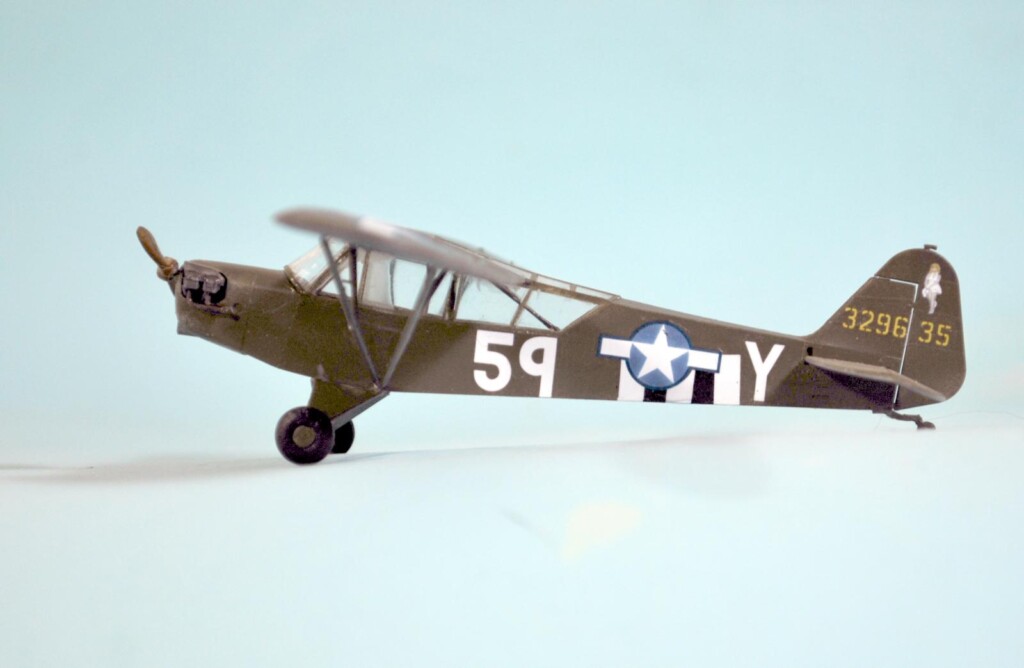
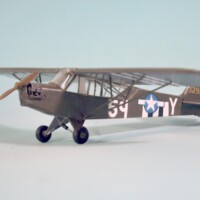
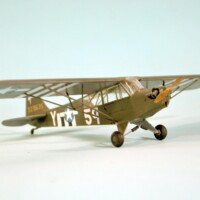

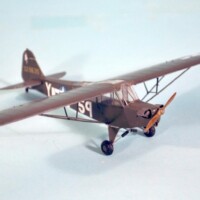
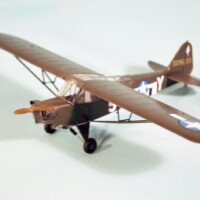

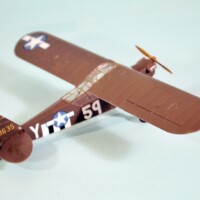
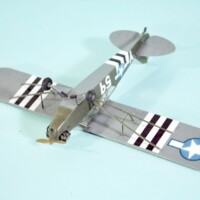
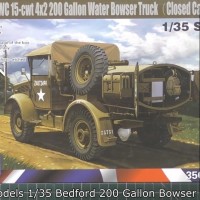
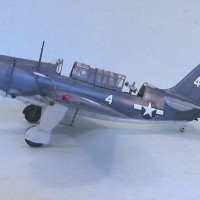

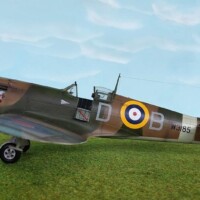
Neat kit of an important aircraft. That “Rosie” gets everywhere, I thought she was a riveter.
A wonderful result and equally wonderful article, Tom! Always a joy to read your articles.
Very nice build, Tom @tcinla
This aircraft was indeed very important during the war.
Thanks for sharing the historical background and the building process.
Beautiful work, must be tiny in this scale even. I like the result on the canopy masking too!
Looks great, Tom. Those are always nice to see at airshows.
War stories and all was fun, but the loverboy surf Cub made my day. That would be a fun diorama don’t you think?
Yes I do. they had to hike two hours to find a phone (no cellphones then).
A nice piece of work and an interesting story. I agree with Pedro on the diorama idea.
Sweet. I'm getting one. Oh those crazy Californians.
Always nice to see the smaller planes being built. Looks good . Great story as well.
That is a lovely little Cub, and definitely on my 'want' list! The Cub, Storch, Auster and Lysander had a very important niche all their own!
The kit and build up looks great! It certainly is easy to tell from here how much better the details are on this kit vs past offerings.
Beautiful work, your Cub looks great! And great story on the history of this very important aircraft, thanks!
Great Cub, Tom!
Great work, Tom (@tcinla). You always make the build sound easier than it turns for me, but I suspect that is the difference between our relative building skills and patience. I have this kit, so I may need to move it farther up the build queue.
Very nice build, and great narrative, the one about the Cub and Storch harkens back to the beginning of aerial combat in WW I. @tcinla
Nicely done! Someone around my neighborhood flies one of these in the same colors, invasion stripes and all!
Great work as usual Tom!
Great build of an icon Tom. Closest I ever got to flying one are my two 1:4 scale RC planes and a 1:6 version. They make great flying scale models!